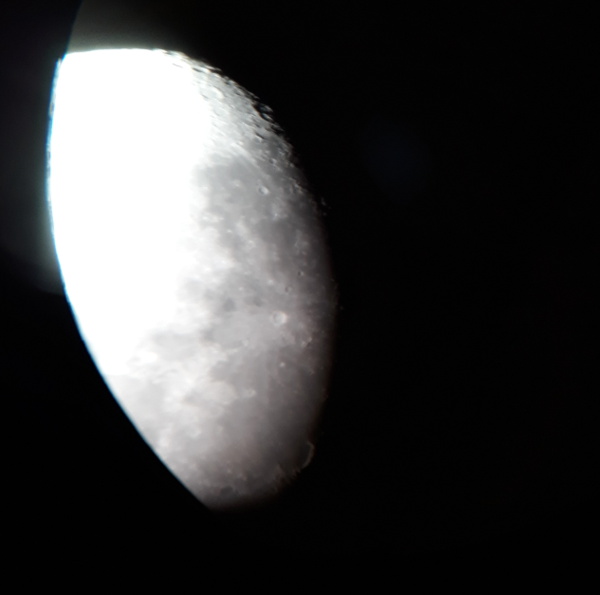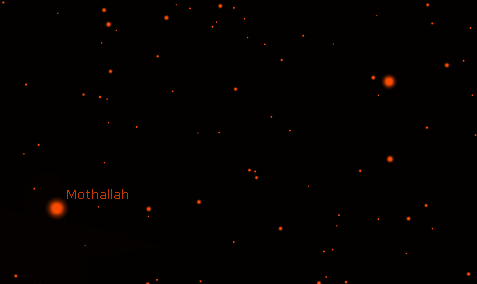Yesterday afternoon, sitting at my desk as dusk was falling, the skies were clear and I could clearly see the moon and Mars rising in the sky. As soon as I logged off from work, I scampered downstairs and went outside, and saw Jupiter and Saturn just visible above the rooftops at the back of the house. “Let’s get the telescope!” I said to The Child Who Likes Animals Space. “Before they set!”
“Before what set?” said The Child, but I was already rushing off to get his telescope and set it up in the back garden.
By the time I’d hoicked it out of its box, Jupiter had already gone down below the roofline, but Saturn was still there. Sadly, I could only see it when I was stood up. The telescope, sitting on a camping table, was too low down to spot it. I briefly considered setting the smaller camping table on top of the larger camping table and making some sort of rickety makeshift telescope-tower, but it would probably have ended in some sort of injury to one or both of us. So, like we’d done before, we looked at the moon, we looked at Mars, and we looked at random bright stars. “Point it at that blue thing!” he shouted. “That’s a very hot star!” This time, at least, he was a lot calmer and could stand still looking through the eyepiece without having to break off every couple of seconds to run back and forth with excitement. I experimented with holding my phone camera in front of the eyepiece. Worst. Astrophotography. Ever.

After The Children decided they’d rather go inside and watch TV I left the telescope set up; and after they’d gone to bed, the skies were still clear. Time for some telescope practice for me, I decided. Using an app on my phone to show me roughly where things were, I tried focusing on key visible stars then swinging the telescope sideways to find a nearby Messier object. The results? Not very successful, other than a possible sighting of M29, the Cooling Tower Cluster.
Getting a rough fix and vaguely hoping to spot the thing clearly wasn’t working. So, I fetched my laptop, and fired up Stellarium in Night Mode. I picked a target—the Triangulum Galaxy—and went looking for it.
Although the skies were clear, the seeing wasn’t great. Even a newbie like me could tell that the seeing wasn’t good. Vega normally stands out to me like a sore thumb, but last night it didn’t really appear any brighter or more significant than the stars of the Northern Cross to its south, which normally are noticably fainter. Nevertheless, I could see Hamal and Sheratan, the brightest stars in Aries, and could spot the telescope nicely onto Hamal and swing it between the two. Zooming in on Hamal in Stellarium, and flicking my head back and forth from the telescope eyepiece to the dim red screen of the computer, I could slowly navigate my way upwards from star to star until I reached Mothallah, which I hadn’t managed to see with the naked eye.

From there, I could similarly hop south towards the spot where the Triangulum Galaxy should be, navigating from star to star and matching the scene in the sky to the screen of the computer. But when I reached it: nothing. Just a blank patch of sky. I found Mothallah again, then worked my way across by a different route. Still nothing. The Triangulum Galaxy has been stolen!
Let’s try the Andromeda Galaxy instead, I thought, given that it’s one of the brightest galaxies in the sky. I found Mirach by eye, spotted the telescope on to it, and walked over to where the galaxy should be. Another blank patch of sky, with a faint hazy blob in the middle of it. Hurrah! A faint hazy blob!
I’m almost glad I hadn’t found it the other day when The Child Who Likes Animals had asked me to find it, because I suspect if I had he’d have been awfully disappointed. I was a bit puzzled, though, because in theory the Andromeda Galaxy is of naked-eye magnitude. I should have seen much more than a fuzzy blob, surely?
A quick note about how astronomical “apparent magnitude”, or brightness to you and me, works. It’s a relative scale based loosely on the subjective scales used by ancient astronomers, and as it’s relative it’s written down as a number without units. The higher the number, the fainter the thing is; and a difference of five in the apparent magnitude number means “a hundred times brighter”. If you have a calculator to hand you can work out that a drop in magnitude of 1 therefore means “2.5119 times brighter”.* The star Vega, mentioned earlier, has magnitude 0, so a few things in the sky have negative magnitudes: Sirius is -1.47, Jupiter varies from -1.66 to -2.94, and Venus from -2.98 to -4.92, almost 100 times as bright as Vega.
On a good night, with a clear dark sky, the human eye should in theory be able to see things as faint as magnitude 6 or so. Last night was clearly nowhere near that: I could see Sheratan at 2.655 and Albeiro (in the Northern Cross of Cygnus) at 3, but couldn’t see Mothallah at 3.42. Through the telescope, though, I was happily stepping my way across the sky using stars of 8 to 8.4, roughly speaking, stars around 140 times less bright than the faintest I could see without it.
The Triangulum galaxy, though, is officially** of magnitude 5.72. Andromeda is considerably brighter still, around the same magnitude as Mothallah. So what was going on?
A galaxy isn’t a point of light, like nearly all stars are. Nearly every star in the sky, other than a handful of stars like Betelgeuse when seen through very high magnifications, appears to be just a single point of light to the viewer here on Earth. A galaxy, by comparison, covers a broad chunk of the sky. That small fuzzy blob I could make out in Andromeda was really just the very brightest core of the galaxy; and the rest of that 3.4 magnitude of light is spread out over an area wide enough to fill my entire eyepiece. Through the telescope, it just becomes a vaguely paler area of sky.
Hopefully at some point we will get the telescope out on a night with rather better viewing conditions, and be able to see all of these things properly. Until then, it seems strangely unintuitive to be able to see hundreds of dimmer stars but not a theoretically many-times-brighter galaxy. That, though, is just how the physics works.
* Apparently, the formal definition “five means a factor of 100” was set down by a Victorian astronomer with what I think is a great name, N R Pogson. The relationship 1:2.5119 is therefore known as Pogson’s Ratio.
** I say “officially”. I mean “according to what I’ve just read on Wikipedia”, of course.
Keyword noise: astronomy, The Children, Saturn, Triangulum Galaxy, Andromeda Galaxy, Messier objects, magnitude, The Moon.

 Home
Home

